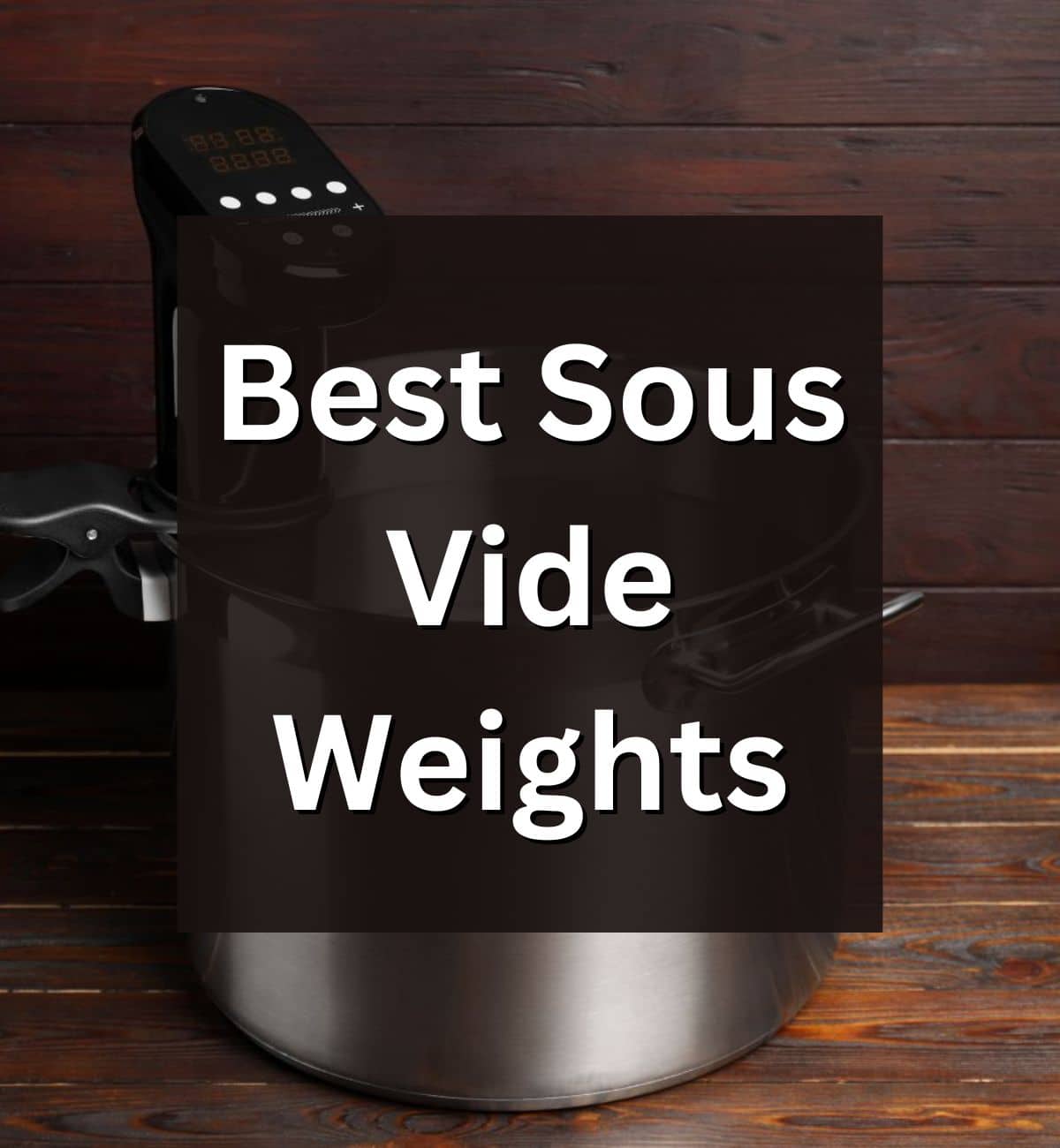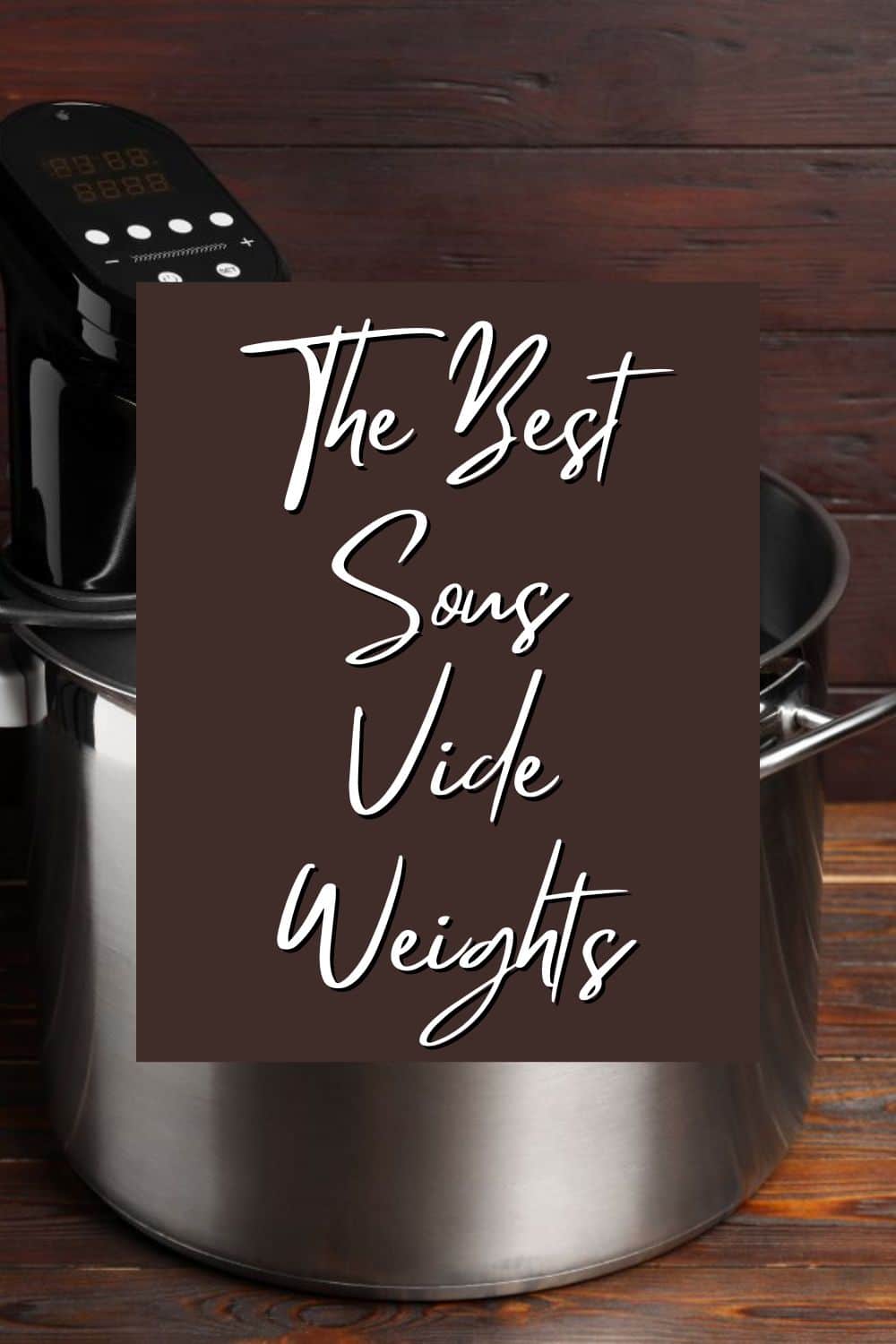This post may contain affiliate links. Please read my disclosure.
Sous vide cooking, originating from the French words for "under vacuum," has revolutionized the way we approach food preparation.
By sealing ingredients in a vacuum-sealed bag and immersing them in a precisely controlled water bath, sous vide allows for the most precise and consistent cooking temperatures imaginable.

Yet, while temperature control is vital, another element often overlooked but equally important is maintaining the positioning of the food within the water bath. This is where sous vide weights come into play, offering a new dimension of culinary excellence.
Read: The Best Sous Vide Machines
Jump to:
What is Sous Vide Cooking?
Before delving into the significance of sous vide weights, it's crucial to understand the essence of sous vide cooking itself and why it is so amazing.
Read: What is Sous Vide Cooking?
The technique was initially developed in the mid-20th century as a means of preserving and enhancing the flavor of food by vacuum-sealing it in bags (make sure you're using the best sous vide bags) and cooking it in a controlled water bath.
Over time, sous vide evolved from a preservation method into a culinary art form celebrated for its ability to achieve consistently perfect results. Precise temperature control with a tool like this sous vide temperature chart is the cornerstone of sous vide, ensuring that food is cooked evenly from edge to center, preserving both moisture and flavor.
Read: The Benefits of Sous Vide Cooking
Want to Save This Recipe?
Enter your email & I'll send it to your inbox. Plus, get great new recipes from me every week!
By submitting this form, you consent to receive emails from Went Here 8 This.
Tips for Keeping Your Bags From Floating
Floating bags can be a common challenge in sous vide cooking, as they can lead to uneven cooking and suboptimal results. Here are some effective tips to keep your vacuum-sealed bags from floating during the sous vide process:
- Use Sous Vide Weights: Using specialized sous vide weights is one of the most straightforward solutions. These weights, whether stainless steel discs, silicone weights, or racks with integrated weights, help keep the bags submerged by applying gentle pressure. We'll talk more about these down below.
- Double-Bagging: Double-bagging involves placing the vacuum-sealed ingredients in a second bag before submerging them in the water bath. This extra layer helps reduce the buoyancy and prevents bags from floating. Be sure to remove excess air from both bags before sealing them.
- Remove all the Air from the Bag: It goes without saying (well, I guess I'm saying) that removing all the air from the bag will help keep it from floating. When you are vacuum sealing liquids, you can freeze the liquids beforehand and add them to the bag frozen so it's easier to vacuum seal.
- Use Heavy Utensils or Tools: If you don't have specialized sous vide weights, you can place heavy utensils or tools on top of the bags. Make sure the items are food-safe and won't interfere with the cooking process. Stainless steel kitchen tools or even oven-safe dishes can serve as makeshift weights.
- Clip Bags to the Side of the Container: Use clips or clamps to secure the bags to the sides of the sous vide container. This technique keeps the bags in place and prevents them from moving around. Be careful not to pierce the bags or compromise the seal.
- Try the Water Displacement Method: A classic technique involves the water displacement method: partially seal the bag with the ingredient inside, leaving a small corner open. Slowly lower the bag into the water bath, allowing the water to push out the air as you go. Once the air is out, seal the bag completely.
- Monitor Bag Placement: As the water bath heats up, bags can sometimes shift due to changes in water movement. Check on the bags periodically to ensure they remain submerged and adjust their positions if necessary.
By implementing these tips, you can minimize the risk of floating bags and achieve consistently excellent results in your sous vide cooking endeavors. That said, bags can still float which is why we also might want to consider sous vide weights.
The Role of Sous Vide Weights
While precise temperature control is paramount in sous vide cooking, keeping the bag in the right place in water bath is equally crucial. The above tips can help, but sometimes you still get that bag float.
When ingredients are vacuum-sealed in a bag, they can sometimes float due to the air trapped within the bag. This is especially true with vegetables, which often expel air while cooking.
This can lead to uneven cooking, potentially resulting in overcooked or undercooked portions. It can also potentially lead to bacteria growth, especially in longer cooks.
This is where sous vide weights come into play. They are specially designed tools that help keep food submerged in the water bath, ensuring even cooking and preventing bacteria from forming.
These weights can take various forms, including racks, magnets, silicone weights and even many DIY options. Their purpose is to prevent the vacuum-sealed bags from floating to the surface, maintaining constant contact between the food and the water at all times.
Types of Sous Vide Weights
Sous vide weights come in various forms and materials, each designed to address the challenge of keeping vacuum-sealed bags submerged in a water bath. Here are five common types of sous vide weights:
- Sous Vide Adjustable Rack: A sous vide adjustable rack is a cooking accessory designed to hold vacuum-sealed bags securely in a water bath during sous vide cooking. Its customizable design allows users to adapt the rack's size to fit various container dimensions, ensuring even cooking by preventing the bags from floating.
- Sous Vide Magnets: Magnetic weights are designed to attach to the bottom or sides of sous vide containers. They are often equipped with magnets that hold onto the container's metal surface, preventing them from moving around. These weights are versatile and can be repositioned easily to accommodate different bag sizes or quantities.
- Food-Grade Silicone Weights: Silicone weights are pliable and flexible, making them ideal for conforming to the shape of vacuum-sealed bags. Silicone weights can be placed along the edges of bags to prevent them from floating while allowing for easy adjustments. I don't love these as they can often move or slip during cooking.
- Mesh Sous Vide Sinker Weights: This weight, often made of food-grade mesh material, is placed inside the bag and holds the ingredients down while allowing water to circulate freely for precise and even cooking.
- DIY Weights: Use cleaned and sanitized glass beads, whiskey stones, fishing weights coins, heavy utensils, pie weights, etc. I recommend placing them in a separate bag (don't let them ever come in contact with your food) that you can use to weigh down your bag.
Each type of sous vide weight has its advantages, and the choice depends on your specific cooking needs and preferences (and budget). Experimenting with different types of weights can help you determine which works best for the types of dishes you often prepare using the sous vide method.
My personal favorite are sous vide magnets as they tend to be high powered and keep food submerged very well.
Regardless of the type you choose, using sous vide weights will significantly contribute to achieving consistent and delicious results in your cooking endeavors.
Advantages of Sous Vide Weights
- Consistency: By keeping the food in place, they ensure that every portion of the ingredient is subjected to the same temperature for the entire cooking duration. This eliminates the risk of undercooked or overcooked sections, delivering a uniformly delicious result.
- Texture Perfection: Foods that are allowed to float can develop uneven textures due to inconsistent exposure to heat. Sous vide weights eliminate this issue, producing ingredients with uniform textures that are as pleasing to the palate as they are to the eye.
- Efficiency: Cooking with sous vide weights can even enhance efficiency. With ingredients kept neatly in place, there's less need to monitor or adjust their positions during the cooking process. This way you can focus on watching your stories.
Choosing the Perfect Sous Vide Weights
Selecting the right sous vide weights for your culinary adventures involves considering several factors:
- Material: Sous vide weights are typically made from stainless steel, silicone, or even food-grade plastic. Stainless steel weights offer durability and easy cleaning, while silicone options are often gentler on bags and containers.
- Weight and Size: Different foods may require different weights to keep them submerged. Consider the weight and size of the ingredients you commonly cook to determine the appropriate sous vide weights for your needs.
- Ease of Use: Look for weights that are easy to attach to the bags or containers, and those that won't interfere with the cooking process. Magnets and rack systems can be particularly user-friendly.
- Compatibility: Ensure that the sous vide weights you choose are compatible with the containers or pots you use for your water bath.
The Best Sous Vide Weights
These are some of the highest rated, best sous vide weights that I recommend:
Conclusion
Whether you're a seasoned chef or an enthusiastic home cook, sous vide weights are a must if you plan on using the technique on a regular basis.
So, the next time you embark on a sous vide adventure, remember that beneath the water's surface, a well-placed weight is working silently to create a symphony of flavors and textures that delight the senses.
How do you weigh floating bags down? Comment below and let us know your best methods!






Isabelle says
I never knew there were weights specifically designed to keep you food submerged. I can't wait to get the magnets!
Danielle says
You're going to love them!